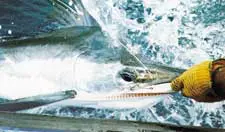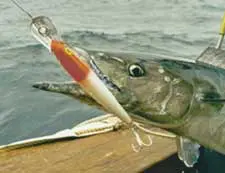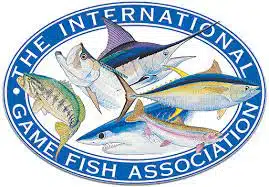Choosing a Suitable Leader Material
It’s usual in saltwater fishing to use a leader at the end of the main fishing line to resist abrasion from the fishing environment (rocks, coral etc ) and from the fish themselves (jaws, sharp gill plates, rough bills of sailfish and marlin etc ).
IGFA rules allow the use of a leader up to 15 feet (4.57 metres ) long in line classes up to 20 lb (10 kg) and up to 30 feet (9.14 metres ) in line classes over 20 lb (10 kg).
In some cases the target species or other species present have sharp teeth which will quickly cut monofilament leaders and necessitate the use of wire or cable leaders or at least a short length of wire or cable at the end of a mono leader.
As a rule, the more strands in a cable the more supple and kink resistant it becomes. However the diameter also increases significantly and it is more likely that during a prolonged fight a fish will gradually be able to cut through the individual strands making up the cable.
It’s a trade off. For a given breaking strain single strand wire will have the greatest bite resistance and the smallest diameter, but will also have the greatest tendency towards kinking. At the opposite end of the scale 49 strand cable will have the least bite resistance and the largest diameter, but will have the greatest resistance to kinking.
However having made the decision to use either a monofilament or a wire or cable leader there are further choices to be made.
The main options are:
:: Monofilament :: | :: Single strand wire :: | :: Multi strand cable :: |
:: Monofilament ::
Nylon monofilament is used worldwide for both mainline and leader material.
It can easily be connected by either knots or crimps, although crimping is an easier and more reliable method with heavy mono.
Leader mono is usually slightly different to mainline mono, particularly in the field of big game fishing. Mainline mono needs to be soft and lack memory to enable it to sit comfortably on a reel spool and to cast and knot easily.
Leader mono needs to have a hard surface and a pronounced memory in order to better resist abrasion and to make it easier for a crewman to handle. Soft mono can dig into a crewman’s gloves and become impossible to let go if a big fish makes a last dash at the boatside. This can be very dangerous for the crewman.
Hard mono however will more easily spring into coils making it easier for the wireman to release the leader if necessary.
For: Cheap to buy, supple, easy to knot or crimp.
Against: Poor resistance to sharp teeth. Large diameter compared to wire or cable of similar breaking strain.

Fluorocarbon
Much that has previously been said about nylon monofilament applies to fluorocarbon monofilament.
The main advantage of fluorocarbon is that its refractive index is close to that of water making it more difficult for fish to see underwater but it is also much more abrasion resistant than nylon allowing thinner leader to be used. It also does not absorb water like nylon and so the wet and dry breaking strengths remain similar.
Fluorocarbon is much more expensive than comparable nylon and more care must be taken when knotting it. When tuna are proving leader shy the traditional solution was to drop down to much lighter leaders which increases the chance of the leader being abraded through during the fight.
The modern solution is to switch to fluorocarbon leader material which is much less visible in water whilst retaining strength and abrasion resistance.
For: Supple, easy to knot or crimp (although slightly more difficult to knot than nylon), more abrasion resistant than nylon, less visible than nylon underwater, UV and temperature resistant
Against: Poor resistance to teeth, expensive to buy. Large diameter compared to wire or cable of similar breaking strain.
:: Single strand wire ::
Single strand wire was for many years the leader material of choice wherever sharp toothed species such as kingfish, wahoo and barracuda were present, even if the target species were marlin or sailfish.
Many traditional methods of bait rigging require the use of single strand wire, although it is not well suited to trolling large lures as the movement of the lure on the leader tends to work harden the wire causing it to fail.

Versatile to use and very thin for its breaking strain, it can only be successfully joined by forming a Haywire twist with barrel wraps.
Its Achilles heel is its tendency to kink if not handled correctly or during a fight with a fish. Once kinked it is permanently weakened and will remain weak even if straightened by hand.
There are two types of single strand wire in common use, stainless steel or monel and tinned or galvanised wire, commonly known as music wire.
Stainless wire (monel)
Monel is the more commonly used of the two types of wire due to its corrosion resistance making it more suitable for reusing.
It is prone to stretching and should be discarded after catching several fish or after any long fight.
For: Cheap to buy, very resistant to sharp teeth, small diameter, corrosion resistance.
Against: Kinks easily, stretches, must be joined by a Haywire twist and barrel wraps.
Tinned or galvanised wire (music wire)
Tinned or galvanised wire (music wire). Music wire is less popular than monel due its lack of corrosion resistance which means that it must be washed in fresh water and dried before storage and checked carefully before reuse.
However music wire does have two advantages over monel. It is even smaller in diameter for its breaking strain than monel and it does not stretch to anything like the same degree as monel.
Australian crews often use music wire (they call it ‘Gal’ ) when fishing dead baits for giant black marlin along the Great Barrier Reef. They find that a small amount of surface corrosion on the wire enables them to more firmly grip the leader with wetted gloves when leadering a big fish alongside the boat.
For: Cheap to buy, very resistant to sharp teeth, smaller diameter than monel, less stretchy than monel, wireman’s gloves can grip it easily.
Against: Kinks easily, must be joined by a Haywire twist and barrel wraps, not corrosion resistant.
:: Multi strand cable ::
Multi strand stainless steel cable is very widely used around the world wherever toothy fish may pick up the bait or lure.
The most common cables available to anglers are 7 strand cable (as the name suggests it is made from 7 individual wires twisted together), and 49 strand cable, which is made from seven 7 strand cables twisted together.
In general 7 strand cable tends to be supplied to anglers with a nylon coating, while 49 strand is usually supplied uncoated.
Nylon coated cable is a pleasant material to use. Relatively small in diameter and easy to work with. The coatings are available in a variety of colours in case that sort of thing’s important to you, and it’s equally suited to fishing with lures or baits and can easily be joined with brass or copper sleeves.
The nylon surface coating does get damaged by fish teeth though and you will probably find that you have to cut back the end of the leader after catching a fish.
Be aware though that salt water can work its way down inside the nylon coating causing corrosion and weakening of the cable after an extended period.
Because it’s so cheap to buy I tend to make up nylon coated leaders when I need them and discard them after each trip.
For: Cheap to buy, resistant to sharp teeth, more supple than single strand wire, small diameter, easy to join with crimps, easy to handle.
Against: More visible than monofilament or single strand wire, fish teeth or abrasion can shred the nylon coating, saltwater can get inside the nylon coating and cause corrosion over a period of time.
Uncoated 49 strand stainless steel cable is the most commonly used cable in higher breaking strains. It’s equally suited to fishing with lures or baits, can easily be joined with brass or copper sleeves and is highly kink resistant.
It’s larger diameter makes it more visible and it’s greater weight can quickly tire out a live bait.
It is more expensive than single strand or nylon coated cable, but if rinsed in fresh water after use it will last a long time.
For: Resistant to sharp teeth, more supple than single strand wire, smaller diameter than monofilament of comparable breaking strain, easy to join with crimps, long lasting.
Against: More visible than monofilament or single strand wire, heavy (only important when using live bait).
Good Fishing!



